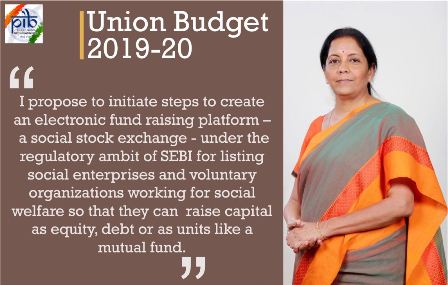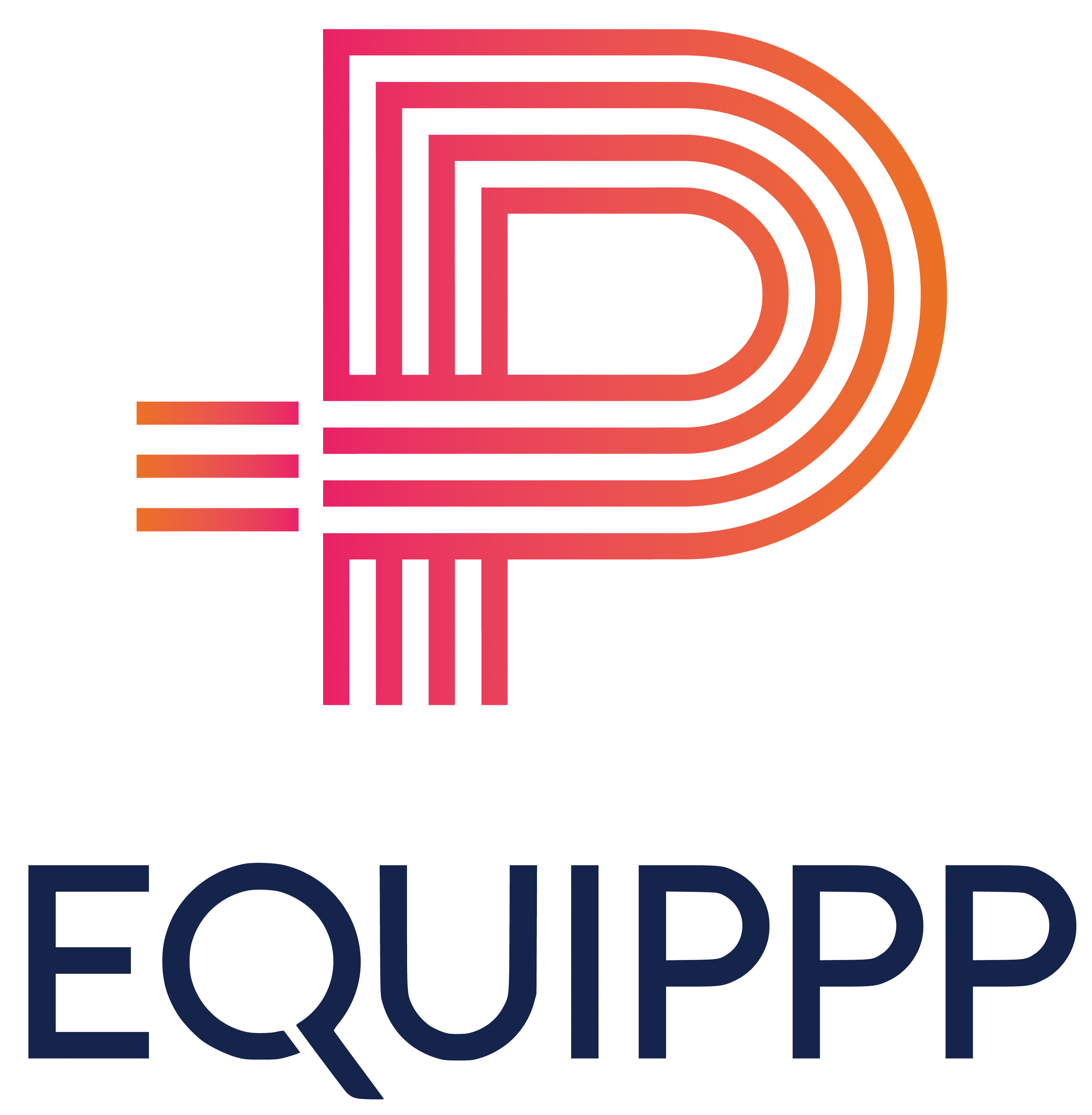Social Stock Exchange (SSE)
Conceptualization
Nirmala Sitharaman ji, Indian Finance Minister in her union budget speech for 2019-2020 on 5 July 2019 proposed setting up of a Social Stock Exchange (SSE).
The Indian Securities regulator, Securities and Exchange Board of India (SEBI) constituted a working group under Mr. Ishaan Hussain in Sep 2019 to prepare a study report on the same.
Securities and Exchange Board of India (SEBI) on 25 Jul 2022 notified the SEBI (Issue of Capital and Disclosure Requirements) (Third amendment) regulations, 2022 laid the way for setting up of Chapter X-A Social Stock Exchange.


There was no formal mechanism for social enterprises and voluntary organizations working for the realization of a social welfare objectives to raise funds/capital. Specifically, in developing countries like India, South Africa, etc., there is dearth of Capital / funds for Social Welfare activities. Social welfare cannot be viewed as a responsibility of the Government alone, instead must be viewed as a joint responsibility of the Government, for profits and not-for-profit enterprises & every single individual of the country.
Objective:
The objective of Social Stock Exchange is to facilitate and help social enterprises, nonprofits, and other social welfare organizations raise funds / capital on the SSE as equity, debt or as units like a mutual fund.
Social Stock Exchanges have been in existence in many countries, including Singapore, the UK, Canada, Brazil, Portugal, etc. Let us try an understand the 3 W’s (Why, When & Where) of Social Stock Exchanges.

Global Perspectives:
The evolution of Social Stock Exchanges is nascent globally; however, SSEs has been in existence over the last couple of years in about seven countries like Canada, Singapore, UK, Brazil, South Africa, Jamaica, and Portugal. These countries permitted businesses operating across industries like health, environment, and transportation to raise funds through this exchange.
It is interesting to note that off the seven SSEs established worldwide, only three (Canada, Singapore, and Jamaica) are currently operational. No comprehensive and insightful research on SSEs and their effects on civil society, with SSEs being explored via the lens of impact investing. Let us take a quick glance at the global Social Stock Exchanges and the purpose they have served to date.
UK:
The SSE started In June 2013, does not allow trading of shares; rather, acts as a business directory of social businesses and a research resource for potential social impact investors. The good news is a social enterprise can register on the SSE & receive visibility for their social businesses. Forbes reported that UK’s SSE has become a strong information repository with a base of 36 member companies and its members have raised GBP 400 million since inception (~INR 37,200 crore) for, affordable housing, clean energy, and new healthcare facilities.
Canada:
Social Venture Connexion started in September 2013. It describes itself as a “trusted connector” giving social entrepreneurs access to service providers, impact investors, high visibility, and a way to evaluate their triple bottom line at competitive rates. SVX started with 12 social enterprises and has facilitated in mobilizing USD 100 Mn (~INR 750 crore) as impact capital for over 100 ventures.
Singapore:
The sole public SSE, “Impact Investment Exchange” started in June 2013, seeking to operate on similar lines of UK’s SSE by disseminating details about reputable social enterprises and impact investment funds. Interestingly, charitable organizations are permitted to issue debt instruments like bonds. IIX’s first instrument women’s livelihood bond listed on the impact exchange helped raise USD 2,010 million (~INR 150 crore). It was the first in the series of IIX sustainability bonds (ISB). Singapore model allows non-profits to issue debt instruments like bonds. Having built a network of over 30,000 partners, IIX Singapore helped raise an impact investment capital of around USD 40 million annually (~INR 300 crore per year).
Canada or Singapore’s SSEs facilitated as a crowdfunding platform for impact investors to invest in social enterprises that match their social investment objectives, unlike the UK SSE which denied transactions on the SSE. Canada or Singapore’s SSEs cater to their country’s needs and offer a great insight into understanding the strengths and weaknesses of the system.
Let us take a quick glance at the Indian Social Stock Exchange, its objectives, progress thus far and the lessons India can learn from the success and failures of some of the Global Social Stock Exchanges.
Current Status:
Our journey on the Social Stock Exchange started in July 2019 with the Indian Finance Minister Mrs. Nirmala Sitaram ji proposing the introduction of Social Stock Exchange in India.
The picture to the right shows us progress from the setting up of the working group to work on the framework in September 2019 till about August 2022, when the Institute of Chartered Accountants of India (ICAI) released its exposure draft on Social Audit Standards (SAS).
Here is a quick snapshot on the objective, who can participate and funds raising methodology on SSE.

Social Stock Exchange was set up with an objective of providing a platform for social enterprises (both, for-profit and not-for-profit social enterprises) to raise funds / capital for realising their objectives of Social Welfare and listing their securities under the regulatory framework of SEBI.
For-profit and not-for-profit social enterprises can register on the SSE and use the platform for raising funds.
Not-for-Profit organizations: Financing methods available for NPO are in the forms of Equity, Zero-coupon, Zero-principal bonds (ZCZP), development impact bonds, a social impact fund with a 100% grants-in grants-out clause, mutual fund donations, etc. A minimum of 75% subscription of the proposed fund raising plans via ZCZP bonds must be achieved by the NPO.
For-Profit organizations: Financing methods available for for-profit organizations can be funds from social venture funds, development impact bonds, debt, or equity.
Social companies can aim:
- to end hunger, poverty, malnutrition, and inequality.
- promoting sanitation, safe drinking water, & health care (including mental health)
- slum area development, affordable housing, creating resilient & sustainable cities.
- promoting people’s livelihoods in rural & urban areas, by raising pay of small-scale & nonfarm workers.
- Preserving forests, animals, mitigating effects of climate change, & adapting to it.
- LGBTQIA+ organizations, women’s emancipation, gender equality is supported.
- Education, employability, and improving livelihood social initiatives are welcome.
What’s Next is the logical question on everyone’s mind, who are tracking this space. A lot needs to be done by the regulator SEBI, potential participants (NPO’s and For-Profits), the Stock Exchanges, ICAI, technology players and Industry participants.
Market Size: In an informal conversation with the regulator SEBI, officials indicated that there are 3.4 million NPO’s operating in India. Even if 1% of the NPO population is assumed to be actively pursuing social objectives, the number is about 34,000 NPO’s. Assuming 10% of the active NPO’s register on the SSE (~3,400) and plan to raise funds, a very conservative market opportunity for SSE could be assumed to be Rs 3,400 Crores.
Way forward: From the above market size information, Indian SSE appears to be having a great opportunity. Are the social enterprises, forprofits social enterprises and not-for-profit enterprises ready to leverage the opportunity that is being provided to them by the Indian Securities Regulator SEBI and the Stock Exchanges (A regulatory Framework) called the Social Stock Exchange?
Actions to be taken by Various Stakeholders
Securities and Exchange Board of India: A lot can be done jointly in consultation with the Indian Finance Ministry and other stakeholders for making the SSE Framework a success. Some quick observations that could be addressed are:
- SSE participants need clarity on fees payable to SEBI/SE’s (@Registration, Fund raising & Renewal).
- Participants need clarity on % of Funds raised which can be incurred as cost of raising capital.
- For NPO’s, Minimum 75% funds subscription criteria (ZCZP Bonds), guidelines for Merchant Banker support / Book Building mechanism to be facilitated subject to 150% commitment via expressions of interest.
- Guidelines to National Institute of Securities Market NISM for Social Auditors Certification Exam.
- Impact assessment is mandatory, however clear guidelines required directing organizations to get impact assessment done by an Independent 3rd Party Social Auditor / Social Impact
Organization.
The National Stock Exchange (NSE) created a webpage for the Social Stock Exchange who just started creating content. NSE received approval on Dec 30, 2022, from the SEBI to set up SSE as a separate segment. NSE quickly needs to act on the same. As of 5th January 2023, only FAQs on Social Stock Exchange exists on the NSE Portal.
National Institute of Securities Market (NISM): was nominated by SEBI to create a certification program content for social auditors and a certification exam which is still awaited. Unless the content, training module and the Certification mechanism is not devised, it could delay the Impact assessment efforts. Hence, NISM should quickly act on the responsibility given by SEBI either on its own or jointly with institutes like Institute of Corporate Affairs and or ICSI and or ICAI or any other Institute approved by the statute.
Other Institutes: Institute of Corporate Affairs and or ICSI and or ICAI or any other Institute approved by the statute should partner with NISM and create content, study modules and partner with NISM for quickly certifying Social Impact Auditors who can start auditing the Organizations raising funds on the SSE.
What challenges exist for the Potential Indian institutions planning to approach SSE?
- The Biggest challenge for the Indian NPO’s / NGO’s / Social Enterprises is “Trust Deficiency.” Some of this social institution mechanism was mis-used in the past for anti-social / money laundering activities which led to the arrest of some of the social activists and social entrepreneurs of such organizations.
- Communilisation amongst communities has limited social welfare equality. Social welfare contributions have been driven by sectoral
divide/ religious organizations. Though the social /religious organization used the funds raised for social welfare purposes, the social welfare got limited to a particular community or sectoral group only. This is evident from the disparity in spends across states leaving majority of the country underdeveloped.
- The image below shows the disparity in the amounts spent across states by CSR obligated companies which is in line with the geographical distribution and spread of business enterprises. The reasons could vary for the geographical spread of organizations across states, and these CSR obligated companies also spend for social welfare and development ofgeographical areas which are in and around their organizations.
- CSR spend increased by Rs 750+ crores from Rs 24,954.78 crores in 2019-2020 to Rs 25,714.65. During the same period spends by other centralized funds across the country have doubled from Rs 1,789.15 Crores in 2019-20 to Rs 3,417.89 Crores indicating an improvement in the fund’s available for social welfare.

Other Challenges faced by Social Institutions:
- While Sec 135 of the Company’s Act was introduced for making social welfare and development a joint responsibility of the government and industry participants, the questions to be asked is “Has the amount of Rs 25,000+ Crores claimed to be spent on social welfare truly made an impact on the Society?” No uniform and independent social impact measurement mechanism exists because of which claims about spends lack transparency and trust.
- Limited resources and availability of funds, limits the social institutions capability of maintaining usage and spend related financial records, leaving scope for misuse or diversion of funds.
Lessons Learnt from Global Perspectives / Global Stock Exchanges?
- One clear lesson learnt by India is enabling the SSE framework into the regulatory framework of the Indian Securities Market Regulator SEBI unlike majority of the global Social Stock Exchanges, which gives the Indian SSE a legal standing.
- Global Social Stock exchanges big challenge was sustainability over long periods. Majority of the global SSEs failed to exist after few initial years. Viz, Brazil 15yrs (2003-2018), South Africa 11 years (2006-2017), Portugal 6 yrs. (2009-2015), UK 4yrs (2013-2017) However, with a large base of Potential Institutions likely to tap SSE in India for raising funds for social welfare and development activities, this challenge may not exist for the Indian SSE.
- Global SSE models and markets are still in the developing stage and institutions without regulatory framework and legislative support could fail fast because of initial teething issues which may not be the case for Indian SSE.
- Global SSES have not used public funds, government funding could serve as an additional source of income in India, where the government has provided the impetus to establish the Indian SSE. For-Profit Organizations can use the platform for joint public-private development projects for raising long term bonds via the Indian SSE.
- A study by the Impact Finance Network in 2018 reviewed 150 impact platforms, including SSEs such as SASIX, SSX, BVSA, and SVX and the results declared were:
> 53% of platforms were unable to finance their operating costs and
> 61.5% received funding from grants.
> 75% of platforms did not generate enough income to fund their operations.
> 60% of these platforms had a small user base (~1,000 users only).
While the above study did not indicate the size of investments being made, it was found that low user base often resulted in platforms being unable to generate enough revenue to sustain themselves, which may not be the case in India, because the Indian SSE is being made part of the larger securities market framework.
What can the Indian Legislature do further to make the SSE Framework a success?
- Amendment to proviso of Sec 135 (5) as suggested below:
– 10% of the earmarked 2% of average net profits for CSR obligation to be reallocated for investments in not-for profit organization’s registered on the Social Stock Exchange. This gives approx. Rs 2,500+ Crore annually for NPO’s registering on SSE for raising funds.
– 50% of the CSR amount earmarked to be spent on the local area and areas around it where it operates, and balance 50% to be allocated for spending on social welfare activities for wholistic development of the country, like Ex: spend in NE states of India which requires funds for social welfare and development.
- For the wholistic development of all the states in India, recommending setting up an investment & development authority in each state with a joint secretary level officer overseeing wholistic development of the State, like Investment & Development Authority of Nagaland (IDAN).
- The objective of the Joint Secretary level officer of the state would be to identify social welfare and development needs in the respective state, facilitate the NPO’s in the state to register with SSE, raise funds for the social welfare and development needs of the respective states via ZCZP bonds.
– Large infrastructure development projects like building of bridges over rivers, Road development projects etc. could be facilitated through Public-private projects (PPP) mode and long term bonds issued by the state government atnominal interest rates.
- Limits for Administrative expenses (% of funds raised including for cost of raising capital) needs to be clearly defined for NPO’s.
- Impact Assessment has been mandated for all participants of SSE, however penal provisions for noncompliance to impact assessment guidelines have not been specified.


